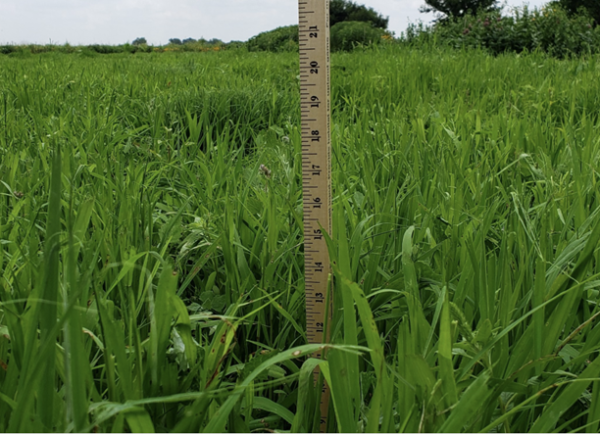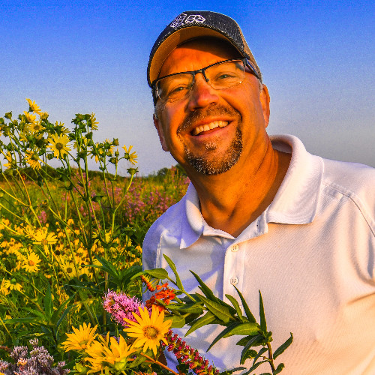There’s a lot of buzz these days about planting pollinators with solar panels — for good reason. Incorporating pollinators provides a slew of benefits for solar installations, agriculture, and the environment. But it’s not as simple as scattering some seeds and hoping for the best. Luckily, through extensive experience and research, we have arrived at best practices that will set you up for success. Inovateus Solar and The Bee & Butterfly Habitat/Conservation Blueprint recently conducted a webinar about these risks and benefits, and the following is a summary of those guidelines that will help avoid common pitfalls.
Why plant pollinators?
Solar developers can make a positive environmental impact by planting pollinators around solar panels. Pollinators do more than just provide habitat for bees, butterflies, insects, and other wildlife. They also sequester carbon, help prevent stormwater runoff, and reduce the use of fertilizers, herbicides, and pesticides; resulting in improved water and soil quality.
What may not be as obvious are the many benefits pollinators provide to solar installations. Pollinator plants can decrease the ground temperature under solar panels, helping panels work more efficiently and produce more power. They can also reduce maintenance costs for solar farms, because mature pollinators require far less mowing than other ground covers.
The benefits don’t stop there. As more solar farms are being developed, many have been facing local opposition. Residents may be concerned that the solar farms will use valuable farmland, ruin views, or change the character of their community. Pollinators can help in several ways, such as by improving solar farm aesthetics. Beekeepers can keep hives around solar pollinator fields to help with honey production. And bringing more pollinating insects to a region helps increase yields for nearby farms. Seeing all these benefits can help communities get on board with solar farms.
As a testament to the benefits, Inovateus Solar, a national solar developer and EPC, has made a commitment to planting pollinators as part of its sustainable solar development. This year, the company has aimed for at least 75% of its solar sites to include pollinator habitat. Inovateus isn’t alone; the trend is becoming popular among solar developers across the U.S. But without the right guidance or experience, it’s easy to go astray — with potentially costly mistakes.
Early planning
That’s where Conservation Blueprint comes in. The company, which creates custom seed mixes for pollinator habitats, has extensive experience tailoring the mixes to the specific needs of solar developers. This is more complex than it might seem; a great overall seed mixture for pollinators might not work well for a solar installation.
Getting it right requires early planning — ideally, before the project has even started. Think of the vegetation as being as important as the electricity that will be generated by the solar panels. The earlier in the process vegetation is considered, the more successful the planting will be.
It’s crucial to involve all parties in these early discussions: the seed mixture designer, the solar developer, and whoever will manage the vegetation.
Panel height
One of the most important things to consider early is the height of the panels in the project.
The utility-scale solar industry is moving to a standard of a lower panel height of 20 to 24 inches off the ground. Many pollinator plants grow taller than this, so they would shade the panels.
 Limiting the plant height to species that don’t grow taller than 18 to 24 inches takes a lot of tools out of your toolbox, but you may be stuck with that if panels are too low.
Limiting the plant height to species that don’t grow taller than 18 to 24 inches takes a lot of tools out of your toolbox, but you may be stuck with that if panels are too low.
A project with a 36-inch lower panel height may be much better suited to pollinator plants. Those 12 inches make a big difference in designing a seed mixture. The good news for solar developers is that the cost difference between 24 inches and 36 inches is minimal.
Site preparation
The next step in early planning is to prepare your site. That might mean removing any existing vegetation. If the site was formerly used for agricultural production, you will need to control the weeds that will grow on the site.
Site preparation can include establishing the pollinator plants before construction. The advantage to waiting until after construction is that you won’t need to replant some of what was planted earlier. But unless a site requires significant grading or you expect to have to replant more than 30% of the site, it’s cost-effective and much easier to establish a uniform pollinator ground cover prior to construction. For that reason, many projects are going this route.
Vegetation management
A vegetation management plan is essential to guide you through details such as site preparation, timing of the planting, method for planting, and determining what equipment to use. Although the pollinator plants account for a tiny fraction of the total project budget, the whole project can be thrown into disarray if the final vegetative cover is not established.
It’s recommended that once it’s established, pollinator habitat be mowed 9 to 12 inches from the ground rather than close to the ground. Timing is key. Mowing weeds before they get out of control is essential while the pollinator plants are still establishing themselves.
Seed selection
Native wildflowers are nice to look at, but they’re not always suited to solar sites. Many don’t tolerate being mowed once or twice a year, and some may grow too tall for your panels. On the other hand, some local ordinances require that you establish vegetative cover using only native plant species, so you should check to see what’s required in your region.
A well-managed solar site may often use white Dutch clover, which Conservation Blueprint often combines with fescues and bluegrass for utility-scale solar farms that have a lower panel height of 20 to 24 inches.
The mixture has a very high seeding rate and establishes itself quickly. Clover, though it doesn’t qualify as a native plant, is highly beneficial to pollinators. But for the maximum benefit to pollinators, it’s best to establish two different seed mixtures for a site. The clover mixture can be used around the panels. Areas on the site without panels, usually about 10% to 20% of a utility-scale project, can be planted with a more traditional pollinator seed mixture that has a minimum of 40 native wildflower species. This approach works best for sites that are at least two acres in size.
About 16 states have solar pollinator scorecards that can help guide you in selecting the optimal seeds for your site. You also want a seed mixture that’s adapted to your site’s soil type and geography.
Conservation Blueprint considers these additional factors when designing an optimal seed mixture:
- Pollinator value. Just because a plant produces a flower doesn’t mean it has great pollinators.
- Project budget. The cost of the seed mixture needs to fit into the total budget.
- Seed availability. Supply issues apply to seeds, too! It’s essential to select a seed mixture with enough available seeds for the project.
- Ease of establishment. Your EPC might want pollinator plants that become established quickly, so they can turn the project over quickly.
- Longevity. If your project has a 30-year lease term, you want a seed mixture that will last and perform well for 30 years.
- Shading tolerance. The pollinator plants seeded within the array area must be able to tolerate some shading.
- Albedo effect. Ideally, the seed mixture that goes under the panels will reflect more sunlight from the ground up, known as the albedo effect. This can help bifacial panels produce more energy.
- Fire resistance. It’s often desirable for a seed mixture to have some resistance to fire.
The future of solar pollinators
The use of pollinator plants with solar continues to be studied. In 2023, the Bee and Butterfly Habitat Fund will begin a program to establish high-quality pollinator habitat with utility-scale solar projects. The program will monitor pollinators such as milkweed for five years and will monitor carbon sequestration at each project for at least six years to determine which seed mixtures work best for that purpose.
But you don’t need to wait for further studies like these to start incorporating pollinator plants into your projects. Following the best practices outlined here will ensure that your solar pollinator efforts bring significant benefits to both your projects and the regions where they are located.
The information in this article is based on a co-webinar presented by Inovateus Solar and The Bee and Butterfly Habitat Fund in November 2022. You can watch a replay of the full webinar here.
 Tyler Kanczuzewski (left), is vice president of sustainability for Inovateus Solar.
Tyler Kanczuzewski (left), is vice president of sustainability for Inovateus Solar.
 Peter Berthelsen (right) is president of Conservation Blueprint
Peter Berthelsen (right) is president of Conservation Blueprint
The views and opinions expressed in this article are the author’s own, and do not necessarily reflect those held by pv magazine.
This content is protected by copyright and may not be reused. If you want to cooperate with us and would like to reuse some of our content, please contact: editors@pv-magazine.com.








By submitting this form you agree to pv magazine using your data for the purposes of publishing your comment.
Your personal data will only be disclosed or otherwise transmitted to third parties for the purposes of spam filtering or if this is necessary for technical maintenance of the website. Any other transfer to third parties will not take place unless this is justified on the basis of applicable data protection regulations or if pv magazine is legally obliged to do so.
You may revoke this consent at any time with effect for the future, in which case your personal data will be deleted immediately. Otherwise, your data will be deleted if pv magazine has processed your request or the purpose of data storage is fulfilled.
Further information on data privacy can be found in our Data Protection Policy.